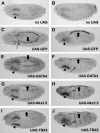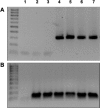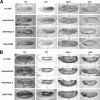Transactivation in Drosophila of human enhancers by human transcription factors involved in congenital heart diseases
- PMID: 21990232
- PMCID: PMC3326377
- DOI: 10.1002/dvdy.22763
Transactivation in Drosophila of human enhancers by human transcription factors involved in congenital heart diseases
Abstract
Background: The human transcription factors (TFs) GATA4, NKX2.5 and TBX5 form part of the core network necessary to build a human heart and are involved in Congenital Heart Diseases (CHDs). The human natriuretic peptide precursor A (NPPA) and α-myosin heavy chain 6 (MYH6) genes are downstream effectors involved in cardiogenesis that have been demonstrated to be in vitro targets of such TFs.
Results: To study the interactions between these human TFs and their target enhancers in vivo, we overexpressed them in the whole Drosophila cardiac tube using the UAS/GAL4 system. We observed that all three TFs up-regulate their natural target enhancers in Drosophila and cause developmental defects when overexpressed in eyes and wings.
Conclusions: A strong potential of the present model might be the development of combinatorial and mutational assays to study the interactions between human TFs and their natural target promoters, which are not easily undertaken in tissue culture cells because of the variability in transfection efficiency, especially when multiple constructs are used. Thus, this novel system could be used to determine in vivo the genetic nature of the human mutant forms of these TFs, setting up a powerful tool to unravel the molecular genetic mechanisms that lead to CHDs.
Copyright © 2011 Wiley Periodicals, Inc.
Figures






References
-
- Albagli O, Klaes A, Ferreira E, Leprince D, Klämbt C. Function of ets genes is conserved between vertebrates and Drosophila. Mech Dev. 1996;59:29–40. - PubMed
-
- Albrecht S, Wang S, Holz A, Bergter A, Paululat A. The ADAM metalloprotease Kuzbanian is crucial for proper heart formation in Drosophila melanogaster. Mech Dev. 2006;123:372–387. - PubMed
-
- Awgulewitsch A, Jacobs D. Deformed autoregulatory element from Drosophila functions in a conserved manner in transgenic mice. Nature. 1992;358:341–344. - PubMed
-
- Barolo S, Carver L, Posakony J. GFP and beta-galactosidase transformation vectors for promoter/enhancer analysis in Drosophila. Biotechniques. 2000;29:726. 728, 730, 732. - PubMed
-
- Basson C, Bachinsky D, Lin R, Levi T, Elkins J, Soults J, Grayzel D, Kroumpouzou E, Traill T, Leblanc-Straceski J, Renault B, Kucherlapati R, Seidman J, Seidman C. Mutations in human TBX5 [corrected] cause limb and cardiac malformation in Holt-Oram syndrome. Nat Genet. 1997;15:30–35. - PubMed
Publication types
MeSH terms
Substances
Grants and funding
LinkOut - more resources
Full Text Sources
Medical
Molecular Biology Databases

